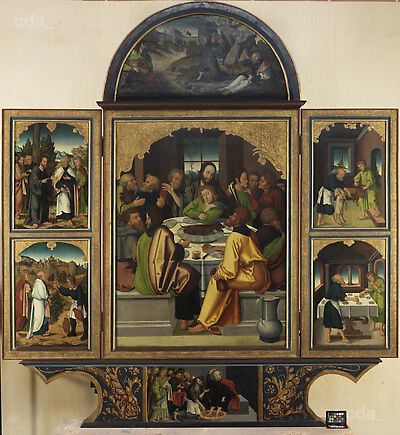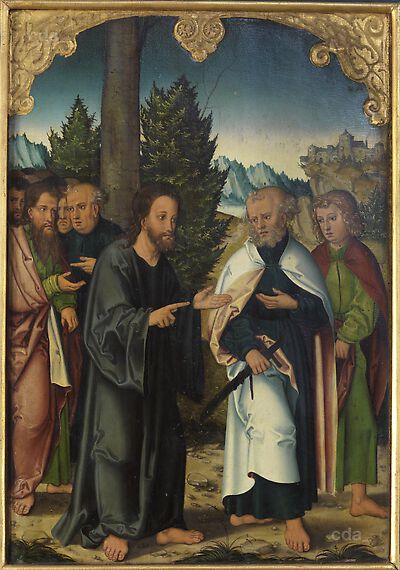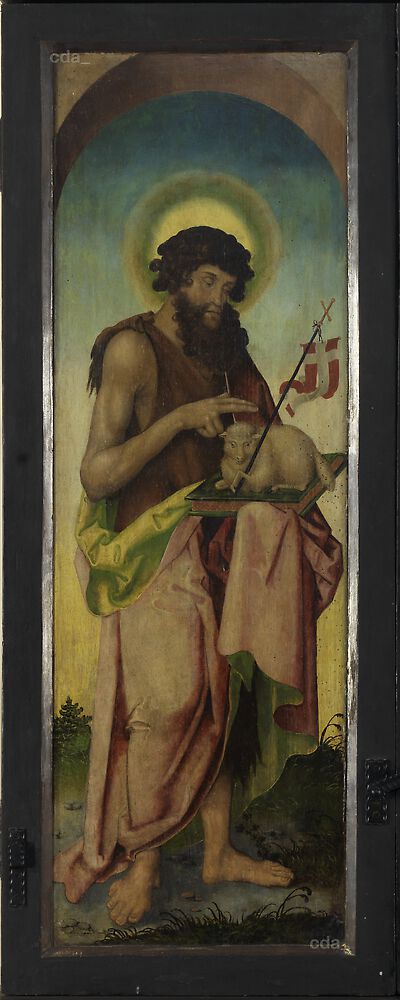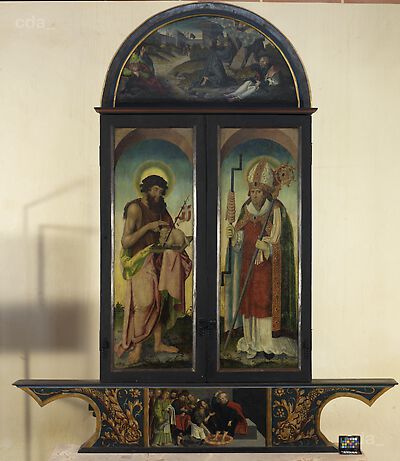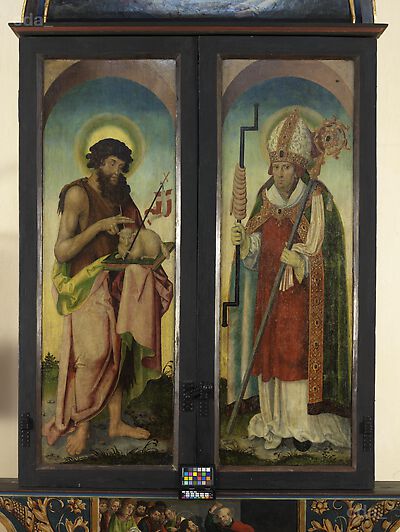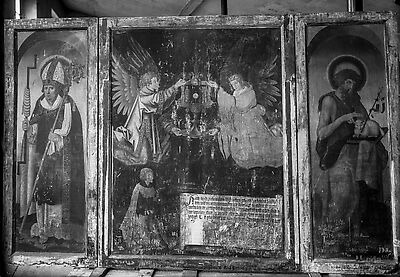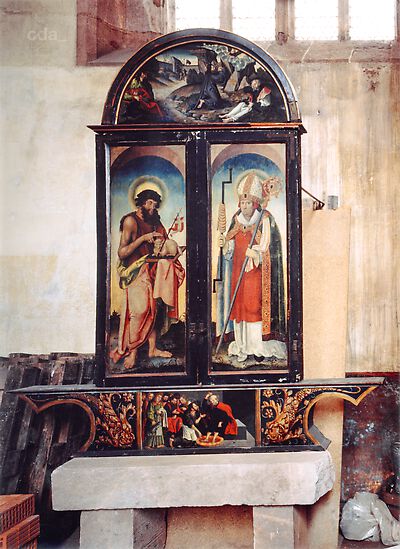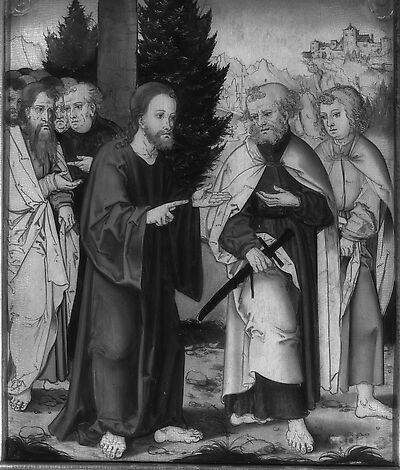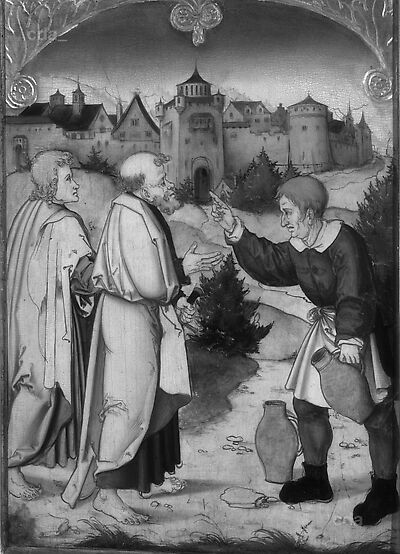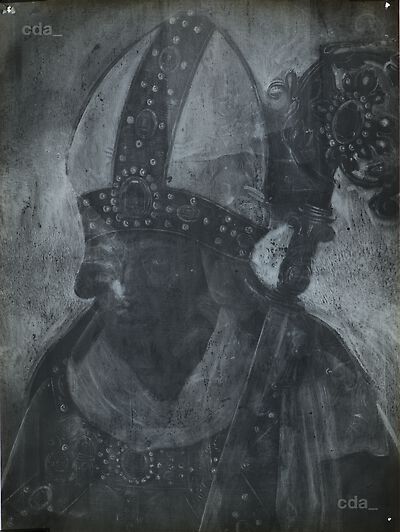This work is a catholic altarpiece. The following two points of reference highlight this:
-
The reformation only reached Rochlitz in the year 1527[1]
-
The epitaph on the reverse makes reference to an altarist. (Altarists worked exclusively for the Catholic Church)
[Thiepold, cda 2014]
The depiction of the Last Supper initially recalls the reformation iconographic program. However, in the 16th century representations of the Last Supper were common both in the Protestant and the Catholic Churches.[2]
The fact that the altarpiece predominantly represents scenes related to the Last Supper is quite unusual. Admittedly, depictions of the Last Supper also number among the protestant altarpieces by Lucas Cranach the Elder, like for example the reformation altarpiece in Wittenberg from 1547 or the Schneeberg Altarpiece from 1539 [DE_WSCH_NONE-WSCH001F], but only in a series with other biblical scenes. Innovative it would seem is that the Hermsdorff retable is exclusively concerned with the day or evening of the Last Supper when displayed open. If this altarpiece was commissioned by the donor for the salvation of the soul, then the iconographical program is in direct contravention with the liturgy of a requiem. The depiction of the Last Supper with reference to the altarist’s function is contradictory as an altarist, in contrast to a priest[3], does not have the authority to celebrate the sacrament of the Eucharist and without a congregation the requiem is so to speak comprised only of the altarist’s silent prayer[4]. Using this knowledge as a starting point three theories can be deduced:
-
The donor expressly desired that the scenes of the Last Supper were represented on his altarpiece, because the altarist was not permitted to celebrate the Eucharist and he wished to have the associated sacrament recorded in the iconographical program. The scene of the Last Supper may also recall the Viaticum, received in the hour of death in preparation for the journey.[5]
-
The donor desired that the altarist celebrate a Holy Mass (the Last Supper) despite his limited authority.
-
Hermsdorff commissioned the altarpiece during his lifetime and had the Last Supper depicted, because as an altarist he had never been permitted to celebrate the sacrament of the Eucharist. The iconographical program thus represents what he never achieved during his lifetime but fervently desired.
[compare: Thiepold 2013, 38-39]
It can be excluded that the altarpiece initially served another purpose. By virtue of the modest size and the fact, that an epitaph was usually commissioned by a donor so that a requiem mass could be held in his honour in front of it, it can be excluded that the altarpiece initially served as the main altarpiece of a church.
[compare: Thiepold 2013, 39]
On the basis of evidence it may be assumed that the epitaph sides were painting after Ambrosius Hermsdorff’s death, in the year 1521. This is suggested by the inscription on the epitaph, which states that Hermsdorff was the altarist of this altarpiece. This would mean that the retable must have already existed. One could assume, that the statement „dißes Altars“ [Thiepold 2013, 36] does not mean the altar retable, but the altar mensa, which was more rarely replaced. However it is more likely that the epitaph sides or reverse was painted retrospectively as is demonstrated below. The former and present location of the altarpiece also suggests that the epitaph sides were a later addition. Due to the architectural situation in the church the side altar could only be installed so that the reverse was against the wall of the north side aisle. It would appear that it was accepted that the Epitaph inscription was only visible on the reverse and would not always be visible to everybody. This suggests that Hermsdorff was not the actual donor or commissioner of the altarpiece, but that as the altarist he had the possibility to leave his epitaph inscription and his image on the verso of the central panel.
[compare: Thiepold 2013, 41-42]
There is a considerable discrepancy between the brushwork on the front and the reverse of the Epitaph altar. This is most apparent in the arrangement of the folds. It seems that the artist responsible for the side with the epitaph imitated the artist who created the other image fields that perhaps already existed. The depiction of the paths with grass and stones are similar, but the painterly quality is worse on the reverse of the altar. The physiognomy of the angel recalls the typical distinctive style of the Master of the Pflocksche Altar, and is not particularly reminiscent of the Cranach workshop.
[compare: Thiepold 2013, 49-65]
As was already mentioned above the shapes of the heads and the physiognomies on the inner sides of the altar were painted in a manner typically redolent of the Master of the Pflocksche Altar. The faces are elongated, the forehead is extremely high. The heads are generally narrow and long, whereas the skullcap appears spherical. This is particularly obvious in the depiction of Judas in the scene of the Last Supper. However it must be pointed out that this image draws heavily on Dürer’s Last Supper from the Passion series and the physiognomies are indeed a little strange. In addition to the physiognomies the posture and the arrangement of the folds exhibit characteristic features found in paintings attributed to the Master of the Pflocksche Altar. The knee of the free leg is often visible beneath the draperies. However the kneecap is generally positioned too low so that the thigh appears too long. It is particularly apparent in the figure of James on the Mount of Olives and Christ in the scene with the washing of the feet that the artist struggled with a correct anatomical representation of the transition from the head to the neck.
[compare: Thiepold 2013, 51-62]
Different painterly qualities can be distinguished on the retable. On the exterior of the wings the representations of St John the Baptist and St Erasmus are of a considerably better quality than the other images. It may be assumed that these were painted by the Master. The images showing the preparation for the Last Supper and the Last Supper may have been executed by the Master with the assistance of workshop members. The stylistic differences evident in the images showing the ‚Agony in the Garden’ and the ‘Washing of the Feet’ suggest they were executed by a workshop member. The reverse of the altar, the side with the epitaph, may also have been painted by a workshop member.
[compare: Thiepold 2013, 70], [Thiepold, cda 2014]
Other than the scene of the Last Supper a further relationship with Dürer’s work can be observed on the retable in the scene of the ‘Agony in the Garden’. Here the artist adopts an almost identical arrangement and representation to that of Dürer’s Apostles Peter, John and James in the engraving of the Agony in the Garden in the Passion series from 1508[6].
[compare Thiepold 2013, 44]
[1] see Heine, Samuel Gottlieb, ed., Historische Beschreibung der alten Stadt und Grafschaft Rochlitz in Meißen, Leipzig (1719) 161
[2] see Harbison, Craig, ‘The northern altarpiece as a cultural document’, in P. Humfrey, M. Kemp, The altarpiece in the Renaissance, Cambridge (1990) 49-75
[3] see Kasper, Walter, ‘Skandal einer Trennung - Offene Kommunion als Zeichen der Hoffnung’, In: Publik-Forum, Heft 45 (1970) 23
[4] see Sander, Kai Gallus, Email an Laura Thiepold, 21.08.2013, verfasst von Prof. dr. theol. Kai Gallus Sander (Katholische Hochschule Nordrhein-Westfalen, Campus Paderborn)
[5] see Angenendt, Arnold, Geschichte der Religiosität im Mittelalter, 2. Aufl., Darmstadt (2000) 668
[6] see Schoch, Rainer et al.: Albrecht Dürer - Das druckgraphische Werk, Bd. 1, Kupferstiche, Eisenradierungen und Kaltnadelblätter, München (2001) 131
![Hermsdorff-Retabel [left wing]](https://lucascranach.org/imageserver-2022/DE_KKR_NONE-KKR001B_FR-none/01_Overall/DE_KKR_NONE-KKR001B_FR-none_2012-04_Overall-s.jpg)

![Hermsdorff-Retabel [central panel]](https://lucascranach.org/imageserver-2022/DE_KKR_NONE-KKR001A_FR-none/01_Overall/DE_KKR_NONE-KKR001A_FR-none_2012-04_Overall-s.jpg)
![Hermsdorff-Retabel [right wing]](https://lucascranach.org/imageserver-2022/DE_KKR_NONE-KKR001C_FR-none/01_Overall/DE_KKR_NONE-KKR001C_FR-none_2012-04_Overall-s.jpg)
![Hermsdorff-Retabel [superstructure]](https://lucascranach.org/imageserver-2022/DE_KKR_NONE-KKR001D_FR-none/01_Overall/DE_KKR_NONE-KKR001D_FR-none_2012-04_Overall-s.jpg)
![Hermsdorff-Retabel [predella]](https://lucascranach.org/imageserver-2022/DE_KKR_NONE-KKR001E_FR-none/01_Overall/DE_KKR_NONE-KKR001E_FR-none_2012-04_Overall-s.jpg)
